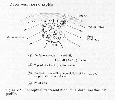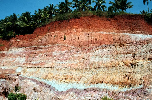|
|
Saprolite
-
Saprolites (rotten rock) retain the structure of the original
rock, however, strong and deep in-situ weathering and leaching softened its
consistency.
-
Saprolite under rainforest may extend down to a depth of tens
or even hundreds of metres. The saprolite is usually less thick on granite
(10-20 m) than on metamorphic rock (40-70 m). The saprolite is normally clayey
because feldspars and ferromagnesian minerals have weathered to clay minerals
and sesquioxides. The sand content of the saprolite reflects the content of
coarse quartz in the original parent rock. Thoroughly weathered saprolites are
chemically nutrient poor despite their lush green rainforest cover.
 |
| Fig.1 Deep weathering profile |
| (
Source: Van Wambeke, 1997.) |
 |
| Fig.2 This is typical soil of southern Kerala, India,
showing a deep weathering profile with a thin cap of transported
petroplinthite. The soil shows the classical sequence of red and mottled clay
over the whitish and bleached pallid zone and the underlying saprolite
rock. |
| (
Source: Beinroth et al., 1996.) |
|
|

 previous | next
previous | next